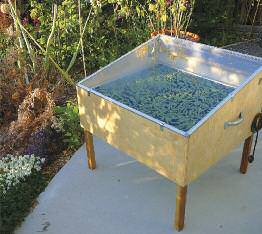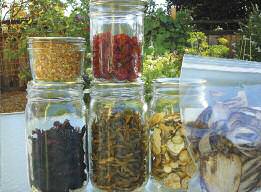edible notables
FALL PRESERVES
Dehydrate your harvest to enjoy this winter.
WRITTEN BY JIM SLOAN
PHOTO COURTESY OF SHELLEY BRANT
One of the oldest known ways of preserving food is drying it. And one of the oldest known drying agents is, well, the sun. Before there were electric and gas ovens or plug-in dehydrators, people were drying their produce in the sun to save it for the winter.
Drying is a safe method of preserving food. Without moisture, microorganisms can’t grow. What’s more, dried food takes up less space and even looks nice on the shelf..
| Dehydrated beets, corn, tomatoes, green beans, and eggplant stand ready |
Also, it’s fairly easy to build your own solar dehydrators. We’re not going to give you directions on how to do it here. But you’ll find tons of digital resources. We share some of our favorites, below.
Before building a solar dehydrator and attempting to dry your produce, read up on the process with a good Cooperative Extension publication such as Drying Fruits and Vegetables from the Pacific Northwest Cooperative Extension. It’s free at www.Extension.oregonstate.edu/lane/sites/default/files/images/pnw0397.pdf. The University of Georgia Cooperative Extension also has an excellent publication, titled Preserving Food: Drying Fruits and Vegetables, available free at www.Uga.edu/nchfp/publications/uga/uga_dry_fruit.pdf.
 |
| A solar dehydrator is used to dry out some home-raised green beans |
Here are some tips for drying fruits and vegetables. Most of these come from Washington State University Cooperative Extension:
• Only dry the best of the crop. Dehydrating an under-ripe apple or tomato won’t improve its flavor.
• Dried vegetables can be used as chips, rehydrated (or reconstituted) as a winter side dish or used in soups, stews, casseroles, and stuffing.
• Dried fruits are good snacks, though sometimes chewy. You also can reconstitute them for pies and the like.
• Use your dried foods within six months to a year. Store in airtight containers.
• When cutting pieces for dehydration, make them all about the same size and thickness so you don’t have a lot of crispy small pieces or gooey big pieces.
• You’ll need to blanch most vegetables before dehydrating. Onions, peppers, and some types of corn are the exception. Steam blanching usually is the way to go.
• Most fruits don’t need pretreatment. Some fruits — such as apples, apricots, peaches, and nectarines — get dark and lose flavor unless you pretreat them. Drying Fruits and Vegetables describes the different ways to pretreat fruit.
• You can purchase solar or electric dehydrators. But if you won’t be satisfied unless you grow your own fruit and vegetables and build your own solar dehydrator, here are some sites that have plans for constructing one:
• www.Geopathfinder.com/9473.html?*session*id*key*=*session*id*val*
• www.Motherearthnews.com/Do-It-Yourself/2006-08-01/Build-a-Solar-Food-Dehydrator.aspx
Jim Sloan is a communications specialist with University of Nevada Cooperative Extension.


